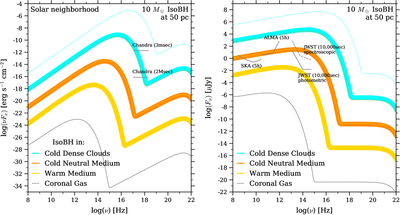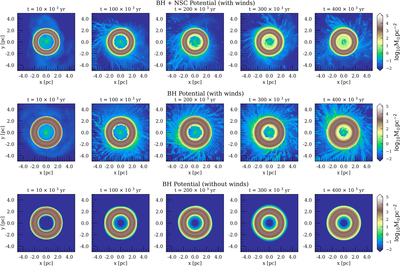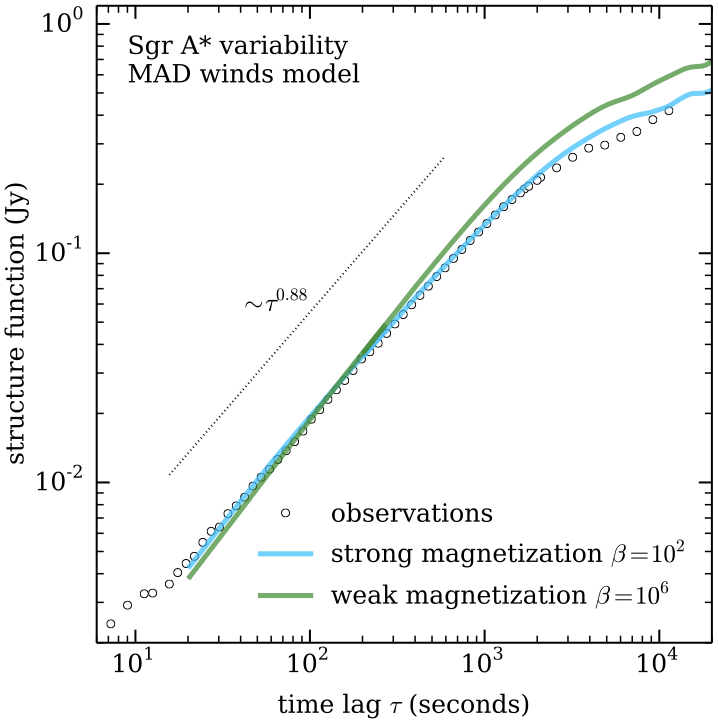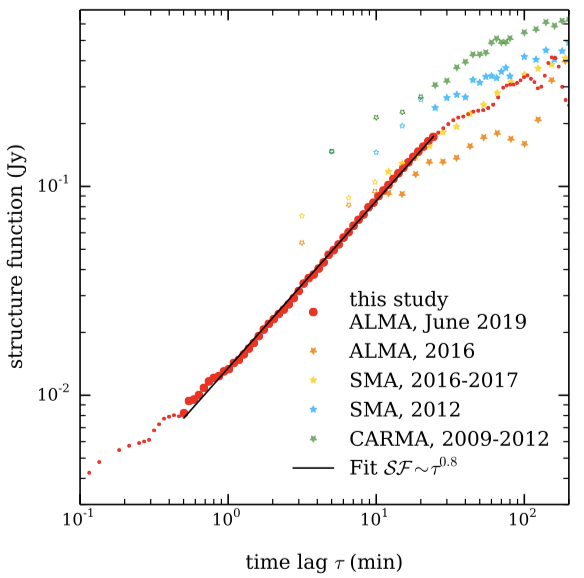and a regular visitor
at the School of Natural Sciences, Institute for Advanced Study.
Mailing address
CIERA, Northwestern University
1800 Sherman Ave
Evanston, IL 60201
Office: CIERA 7409
email: lena AT northwestern DOT edu
When I am at the IAS you can find me in Bloomberg Hall 249 and at lena AT ias DOT edu
Education
PhD, Astrophysics, California Institute of Technology
PhD, Particle Physics, Moscow State University
Specialist, Theoretical Physics, Moscow State University
Past affiliations
2022-23 Black Hole Initiative Fellow, Harvard University
2018-22 Member, Institute for Advanced Study, +2022-23 Visitor
Research
I am a physicist working on a range of topics in astrophysics. I am primarily interested in black holes, their accretion and emission. Due to its proximity the Milky Way's Galactic Center black hole Sagittarius A* is common subject of my papers.
The research work conducted in my group combines observations, hands on data analysis, pen-and-paper theory, and simulations. Our approach to astrophysics is problem oriented, rather than tool oriented. We identify what is necessary to solve big problems, acquire the necessary skills and tools, and, when necessary, develop new techniques like new algorithms for telescope data analysis. Because solving big problems requires attacking them from multiple sides and always keeping the big picture in mind.
In my past I also used to write papers in elementary particle physics and string theory.
Research Group
Dr. Mark Goski (postdoc, CIERA Fellow -> Research Assistant Professor, CIERA)
Asad Ukani (graduate student, since 2023)
Edward Skrabacz (graduate student, since 2024)
Past Group Members
Nycole Wenner (PhD 2025 -> Adler Planetarium)
Courses Taught
Fall 2024: Classical Mechanics (PHYS 411)[course page]
Spring 2024: General Relativity - Applications (PHYS 445-2) [course page]
Spring 2025: General Relativity - Mathematical Foundations (PHYS 445-2)
Spring 2026: General Relativity (PHYS 445-2)
Spring 2025: Scientific Communication (PHYS/ASTRO 390/490)
IAS Astrophysics learning seminar: Gravitational Waves [notes]
IAS Astrophysics learning seminar: Plasma Physics [notes]
Quantum Field Theory (offered at the Department of Mechanics and Mathematics, Moscow State University)
Some Recent Works
Full list of publications is available on ArXiv and
ADS
(published as Lena Murchikova, Elena Murchikova and E.M. Murchikova)

|
The Discovery of a Large Active Wind from the Milky Way's Central Black Hole Mark D. Gorski and Elena Murchikova, Submitted Every large galaxy has a black hole in its center. The interaction between the black hole and their host profoundly shapes galactic evolution and the Universe as a whole. The key feature of this interaction are black hole jets - or more generally winds - which every black hole must have. Despite our Galaxy's central black hole, Sagittarius A* (Sgr A*), proximity and importance, the active wind from it has eluded scientists for over half a century. Here we report the discovery of a large active wind from Sgr A* using unprecedentedly deep observations with the Atacama Large Millimeter/Submillimeter Array (ALMA). We detect a large conical clearing in the cold molecular gas surrounding Sgr A* that is at least 1 parsec in length and has a 45-degree opening angle. The morphology and energetics of this structure are consistent with active clearing by a hot wind from Sgr A*. This finding resolves the long-standing mystery of the missing wind from Sgr A*, and delivers the most detailed look yet of black hole feeding and feedback processes in our Galactic center. |
|

|
Observability of Isolated Stellar-mass Black Holes Lena Murchikova and Kailash Sahu, The Astrophysical Journal Letters 988 1 L12 (2025) Stellar-mass black holes (BHs) represent the natural end states of massive stars. It is estimated that 10^8 stellar-mass BHs are present in the Milky Way galaxy, a significant fraction of which are expected to be isolated. Despite their expected abundance, only about 20 have been detected so far - mostly in binary systems - with just one confirmed isolated black hole (IsoBH) identified via astrometric microlensing. In this study, we investigate the potential for detecting electromagnetic emissions from IsoBHs by generating synthetic model spectra of their emissions in different types of interstellar medium environments. These model spectra are then compared with current observational capabilities. We show that photons emitted by IsoBHs - especially those accreting material in dense environments or within the Solar neighborhood - should be readily detectable. However, confidently identifying these sources remains highly challenging. We conclude that a number of IsoBHs must already exist in current astronomical catalogs but have not been identified as such. We outline possible strategies for detection and identification of IsoBHs using the current and upcoming telescopes. |
|

|
The Inner 2 pc of Sagittarius A*: Simulations of the Circumnuclear Disk and Multiphase Gas Accretion in the Galactic Center Siddhant Solanki, Sean M. Ressler, Lena Murchikova, James M. Stone, Mark R. Morris, The Astrophysical Journal 953 1 22 (2023) The inner few parsecs of the Milky Way's Galactic Center contains the central accreting supermassive black hole, over a million stars, and multiple large gaseous structures. In the past, the structures at these length scales have generally been modelled independently of each other. It is consequently not well understood how these complex features interact with each other nor how gas flows between the outer few parsecs and the inner sub-arcsecond region (1 arcsec ~ 0.04 pc). In this work we present hydrodynamic simulations of the inner few parsecs of the Milky Way's Galactic Center that, for the first time, combine a realistic treatment of stellar winds and the circumnuclear disk as they interact with the gravitational potential of the nuclear star cluster and Sagittarius~A*. We observe interactions of the stellar winds with the inner edge of the circumnuclear disk, which leads to the growth of instabilities, induced accretion of cool gas from the inner edge of the disk, and the eventual formation of a small accretion disk of ~ 10^4-10^5 K within r ~ 0.1 pc. The formation of an inner disk qualitatively agrees with observations. This disk grows in radial extent and mass with time on >~ 10 kyr timescales, with a growth rate of M ~ t^3.5. We discuss additional physical mechanisms not yet included in this work that can improve our model. |
|

|
Remarkable correspondence of Sagittarius A* submillimeter variability with a stellar-wind-fed accretion flow model Lena Murchikova, Christopher J. White, Sean M. Ressler, The Astrophysical Journal Letters 932 L21 (2022) We compare the 230 GHz near-horizon emission from Sagittarius A* to simulations representing three classes of accretion flows. Using the structure function to capture the variability statistics of the light curve, we find a noticeable discrepancy between the observations and models based on torus-fed accretion disks, whether those disks bring in a small or large amount of net magnetic flux. On the other hand, the simulations that are fed more realistically by stellar winds match the observed structure function very well. We describe the differences between models, arguing that feeding by stellar winds may be a critical component in constructing theoretical models for accretion in the Galactic Center. |
|

|
Neutral Gas within 20,000 Schwarzschild radii of Sagittarius A* Elena M. Murchikova, Tianshu Wang, Brian Mason, Roger D. Blandford, submitted Murchikova et al 2019 discovered a disk of cool ionized gas within 20,000 Schwarzschild radii of the Milky Way's Galactic Center black hole Sagittarius A*. They further demonstrated that the ionizing photon flux in the region is enough to keep the disk ionized, but there is not ample excess of this radiation. This raised the possibility that some neutral gas could also be in the region shielded within the cool ionized clumps. Here we present ALMA observations of a broad 1.3 millimeter hydrogen recombination line H30alpha: n = 31 -> 30, conducted during the flyby of the S0-2 star by Sgr A*. We report that the velocity-integrated H30alpha line flux two month prior to the S0-2 pericenter passage is about 20% larger than it was one month prior to the passage. The S0-2 is a strong source of ionizing radiation moving at several thousand kilometers per second during the approach. Such a source is capable of ionising parcels of neural gas along its trajectory, resulting in variation of the recombination line spectra from epoch to epoch. We conclude that there are at least (6.6 +- 3.3)x10^{-6} Msun of neutral gas within 20,000 Schwarzschild radii of Sgr A*. |
|

|
Second Scale Submillimeter Variability of Sagittarius A* during flaring activity of 2019: On the Origin of Bright Near Infrared Flares Lena Murchikova and Gunther Witzel, The Astrophysical Journal Letters 920 1 L7 (2021) In 2019, Sgr A* -- the supermassive black hole in the Galactic Center -- underwent unprecedented flaring activity, brightening by up to a factor of 100 compared to quiescent values. Here we report ALMA observations of Sgr A*'s continuum variability at 1.3 mm (230 GHz) -- a tracer of the accretion rate -- conducted one month after the brightest detected near infrared (NIR) and in the middle of the flaring activity of 2019. We develop an innovative light curve extraction technique which (together with ALMA's excellent sensitivity) allows us to obtain the light curves which are simultaneously of high time resolution (2 seconds) and high signal-to-noise ratio (~ 500). We construct an accurate intrinsic structure function of the Sgr A* submm variability, improving on previous studies by about two orders of magnitude in timescale and one order of magnitude in sensitivity. We compare the June 2019 variability behavior with that of 2001-2017, and suggest that the most likely cause of the bright NIR flares is magnetic reconnection. |
|
| S0-2 star, G1- and G2-objects and flaring activity of the Milky Way's Galactic Center black hole in 2019 Lena Murchikova, The Astrophysical Journal Letters 910 L1 (2021) In 2019, the Galactic center black hole Sgr A* produced an unusually high number of bright near-infrared flares, including the brightest-ever detected flare (Do et al 2019, Gravity 2020). We propose that this activity was triggered by the near simultaneous infall of material shed by G1 and G2 objects due to their interaction with the background accretion flow. We discuss mechanisms by which S-stars and G-objects shed material, and estimate both the quantity of material and the infall time to reach the black hole. |
||

|
Reconstructing EUV spectrum of star forming regions from millimeter recombination lines of HI, HeI, and HeII Lena Murchikova, Eric J. Murphy, Dariusz C. Lis, Lee Armus, Nadia Zakamska et al, The Astrophysical Journal (2020) The extreme ultraviolet (EUV) spectra of distant star-forming regions cannot be probed directly using either ground- or space-based telescopes due to the high cross-section for interaction of EUV photons with the interstellar medium. This makes EUV spectra poorly constrained. The mm/submm recombination lines of H and He, which can be observed from the ground, can serve as a reliable probe of the EUV. Here we present a study based on ALMA observations of three Galactic ultra-compact HII regions and the starburst region Sgr B2(M), in which we reconstruct the key parameters of the EUV spectra using mm recombination lines of HI, HeI and HeII. We find that in all cases the EUV spectra between 13.6 and 54.4 eV have similar frequency dependence: L_\nu ~ \nu^{-\gamma} ~\nu^{-4.5 +/- 0.4}. We compare the inferred values of the EUV spectral slopes with the values expected for a purely single stellar evolution model (Starburst99) and the Binary Population and Spectral Synthesis code (BPASS). We find that the observed spectral slope differs from the model predictions. This may imply that the fraction of interacting binaries in HII regions is substantially lower than assumed in BPASS. The technique demonstrated here allows one to deduce the EUV spectra of star forming regions providing critical insight into photon production rates at < 912 Angstrom and can serve as calibration to starburst synthesis models, improving our understanding of star formation in distant universe and the properties of ionizing flux during reionization. |
|

|
Peas in a Pod? Radius correlations in Kepler multi-planet systems Lena Murchikova & Scott Tremaine, The Astronomical Journal (2020) In this work we address the claim of Weiss et al. (2018) that the radii of adjacent planets in Kepler multi-planet systems are correlated. We explore two simple toy models---in the first the radii of the planets are chosen at random from a single universal distribution, and in the second we postulate several types of system with distinct radius distributions. We show that an apparent correlation between the radii of adjacent planets similar to the one reported by Weiss et al. (2018) can arise in both models. In addition the second model fits the radius and signal-to-noise distribution of the observed planets. |
|

|
A Cool Accretion Disk around the Galactic Centre Black Hole Elena M. Murchikova, Anna Pancoast, E. Sterl Phinney, Roger D. Blandford, Nature (2019) A supermassive black hole SgrA* with the mass ~4x10^6 Msun resides at the centre of our galaxy. Building up such a massive black hole within the ~10^10 year lifetime of our galaxy would require a mean accretion rate of ~4x10^-4 Msun/yr. At present, X-ray observations constrain the rate of hot gas accretion at the Bondi radius (10^5 R_Sch = 0.04 pc at 8kpc) to \dot{M}_Bondi ~ 3x10^-6 Msun/yr, and polarization measurements constrain it near the event horizon to \dot{M}_horizon ~ 10^{-8} Msun/yr. A range of models was developed to describe the accretion gas onto an underfed black hole. However, the exact physics still remains to be understood. One challenge with the radiation inefficient accretion flows is that even if one understands the dynamics there is no accepted prescription for associating emissivity (and absorption) with the flow. The other issue is the lack of model-independent probes of accretion flow at intermediate radii (between few and ~ 10^5 R_Sch), i.e. the constraints that do not assume a model of accretion flow as an input parameter. We report detection and imaging of the 10^4 K ionized gas disk within 2x10^4 R_Sch in a mm hydrogen recombination line H30alpha: n = 31 -> 30 at 231.9 GHz using the ALMA. The emission was detected with a double-peaked line profile spanning full width of 2,200 km/s with the approaching and the receding components straddling Sgr A*, each offset from it by 0.11arcsec= 0.004pc. The red-shifted side is displaced to the north-east, while the blue-shifted side is displaced to the south-west. The limit on the total mass of ionized gas estimated from the emission is 10^-4 - 10^-5 Sun at a mean hydrogen density 10^5-10^6 cm^-3, depending upon whether or not we assume the presence of a uniform density disk or an ensemble of orbiting clouds, and the amplification factor of the mm radiation due to the strong background source which is Sgr A* continuum. |